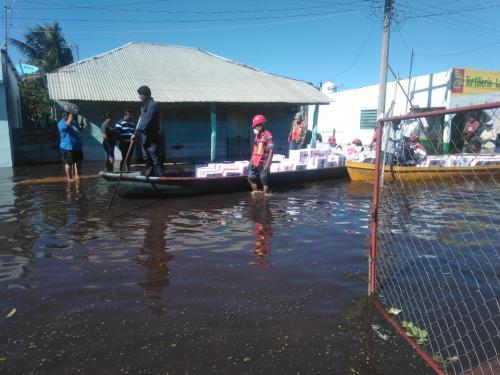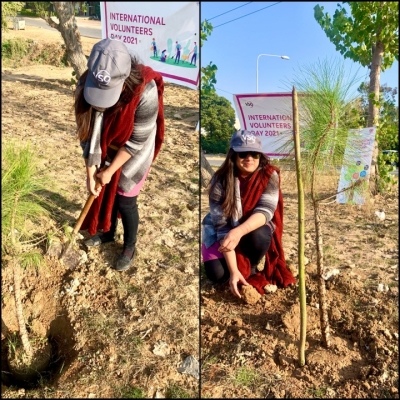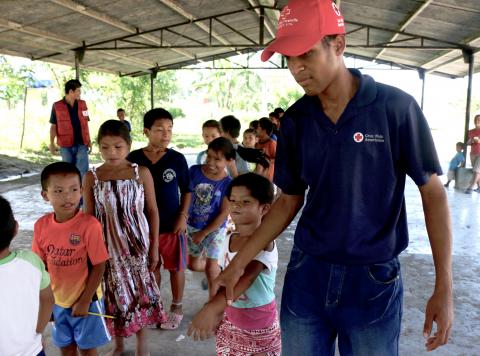Community brigades were put to the test during floods in Tabasco, Mexico

When Tabasco experienced the most severe floods in decades last autumn local community brigades were put to the test. Leveraging their human and social capital developed through our joint work they provided early warning and quickly organized first response operations in cooperation with Civil Protection and the Mexican Red Cross.
Creating community brigades to build flood resilience
The Mexican Red Cross has worked with flood prone and marginalized communities in Tabasco as part of the Zurich Flood Resilience Alliance since 2013. These are communities who used to struggle to access the support they needed, and lacked social mechanisms for preventing and responding to floods.
To fill these gaps the Mexican Red Cross have initiated and supported the creation of community brigades. These community-based groups of up to ten people receive training on for example evacuation, shelter, and first aid and are equipped with resources including tools, first aid kits, and protective equipment. Special attention is being paid to social inclusion so that the brigades reflect the diversity of community members.
The idea behind the brigades is to strengthen the first link in the emergency response chain. So that when hazards occur, the community is able to self-organize and respond to the emergency until external support arrives. Once support arrives, the community brigades can support with coordination, management, and provision. Brigades in the different communities we work with are connected with each other and with relevant authorities and institutions, particularly with the institute for Civil Protection, a national government body responsible for protecting the population during disaster events.
Since brigade members are part of the communities, they are present not only in the aftermath of a disaster, but can engage in longer term activities. For example raising awareness of flood risks.

The worst floods in a decade
In October and November 2020, several cold fronts as well as hurricanes Eta and Iota brought intense rainfall and floods to Tabasco. Communities we are working with, or have worked with in the past, as part of the Zurich Flood Resilience Alliance were badly affected. These were the worst floods since 2011. Road Access was cut, people’s homes flooded, and crops were lost. Many community members were forced to evacuate, often more than 40 kilometers from their homes.
While the floods were the worst in a decade, communities were prepared. The community brigades proved to be of great value to their communities before, during, and after the floods.

Put to the test, community brigades demonstrate their value
Recognition of the community brigades by local authorities, particularly Civil Protection, was really valuable as it meant they received the latest forecasts and information. This was passed between brigades and onto other community members who could take timely action to prepare. For example, some families removed assets and belongings from flood threatened areas and stored them in safe places.
The good communication between the brigade coordinators was helpful to know what was happening in each community and what actions the communities have taken.
Yngrit Pérez, Brigade Member
Thanks to the early warnings, and strong communication between stakeholders, community brigades could start planning response activities even before the flood arrived. In Monte Grande for example community members cooperated to purchase fuel and, together with the Civil Protection of the Municipality of Jonuta, worked to remove the water using motor pumps provided by the Zurich Flood Resilience Alliance.

Community brigades are able to identify needs and receive support
Through their connections with Civil Protection and the Mexican Red Cross the community brigades were able to quickly access emergency support. In Monte Grande they carried out a Damage Assessment and Needs Analysis (DANA) which was used to request specific support from government institutions.

The brigade coordinator communicated directly with the coordinator of the Civil Protection Institute of the State of Tabasco and was able to express the community’s needs. As a result, the Mexican Army delivered 450 food parcels and the federal government activated a water treatment plant.
I consider that the benefits of the brigade were that we were able to create the situation report, to communicate about the situation in each community, and to send the report to the state civil protection. Fortunately they answered our mail. They know that there are brigades in Jonuta, and that they are active and ready to help during the emergency.
Yngrit Pérez, Brigade member
The community brigades also mobilized to support recovery activities led by Mexican Red Cross, generously supported by Zurich Mexico. Together with Red Cross staff and volunteers, community brigades distributed health kits to households. These were accompanied by sessions to promote good practice health and hygiene, particularly important in light of the ongoing COVID-19 pandemic.
Seeing the importance of brigades more community members want to join
After the floods, as community members have seen the value of community brigades in an emergency, interest in joining has grown significantly. In the past we have faced challenges with limited participation in some communities. Since the flood it has been much easier to inspire community members to join and invest in the local brigade.

Nation-wide recognition and scale-up of the community brigade methodology
This latest test for the community brigades has once again highlighted the important role they play in building community flood resilience. There are strong arguments for establishing similar community-based groups in other flood prone communities, in Mexico and elsewhere.
It’s great that the local, state, and federal authorities recognize this too. In 2019 the Mexican Red Cross received the National Civil Protection award for the community brigade methodology we’ve developed and it has been included in Tabasco’s most recent State Development Plan (2019 – 2024).
If you want to find out more about the work that the Mexican Red Cross is doing as part of the Zurich flood Resilience Alliance have a look at our where we work page or our Year 2 Learning Report where you can find a case study about the community brigades.
This blog was written by Jonathan Ulrich, Jimena Cueva, Brenda Avila Flores and Francisco Gabriel Reyes and originally published on the Flood Resilience Portal of the Zurich Flood Resilience Alliance. Please find the original story here. To learn more about the flood resilience work of the Mexican Red Cross, check out this country brief.



